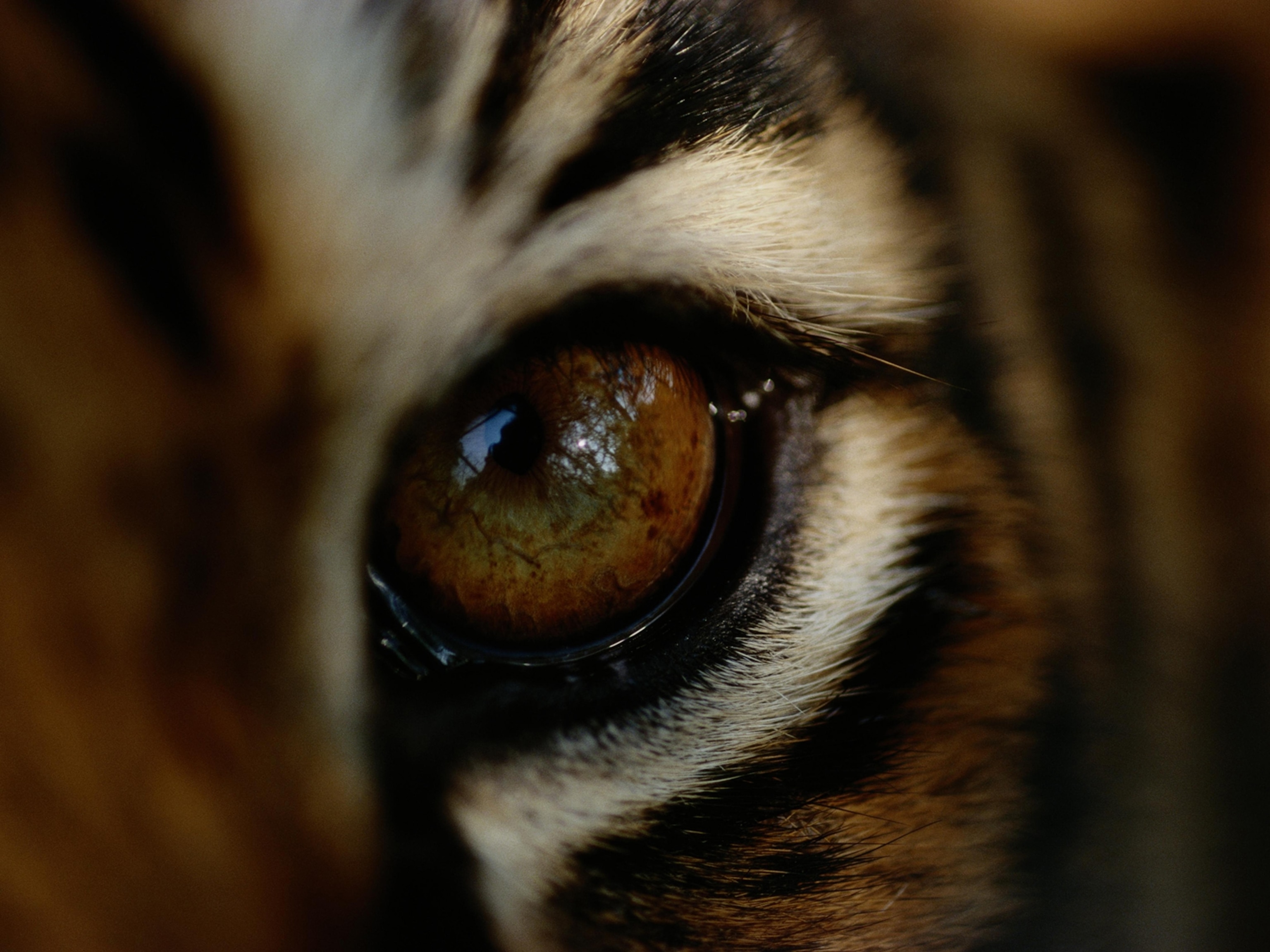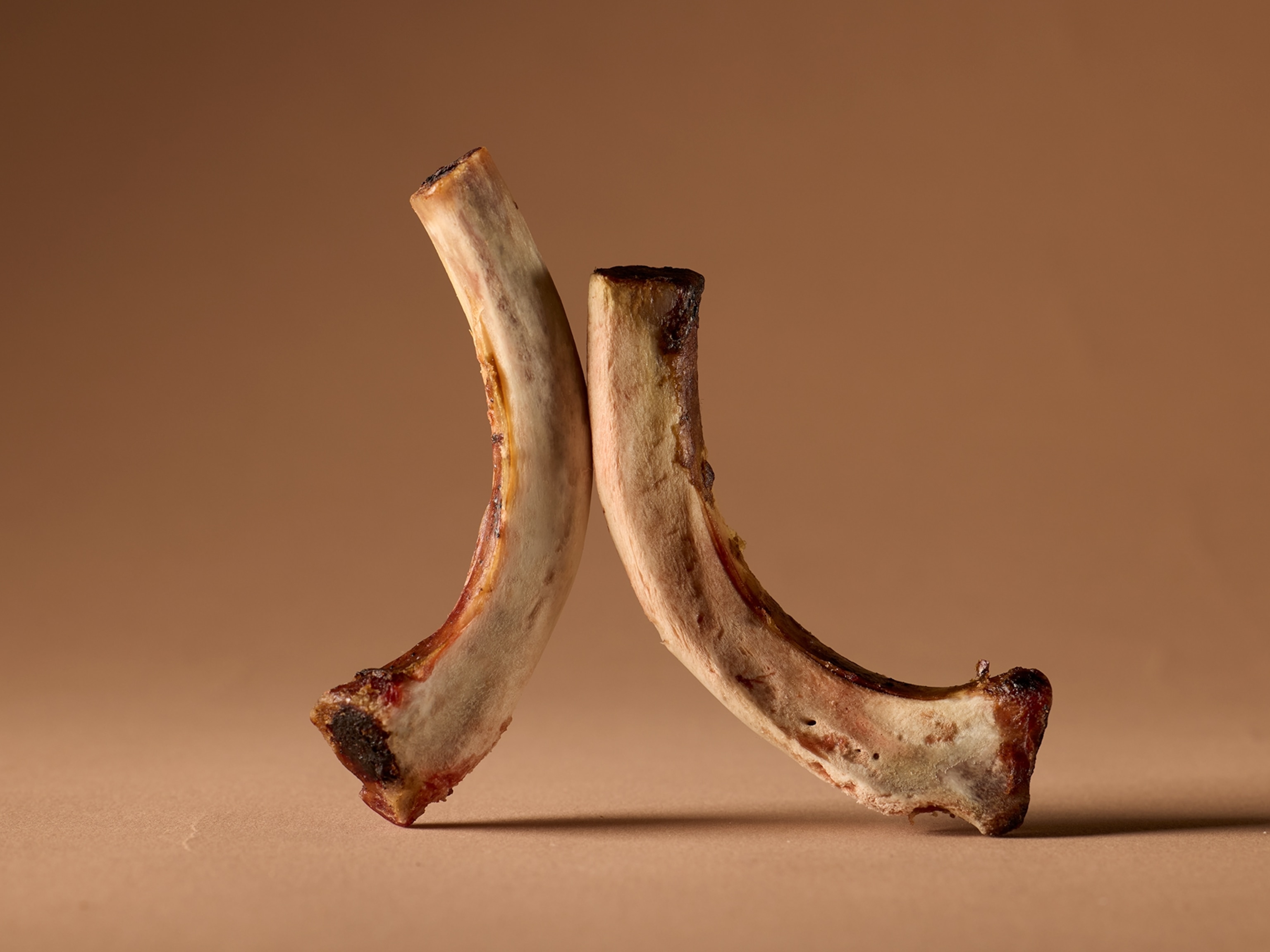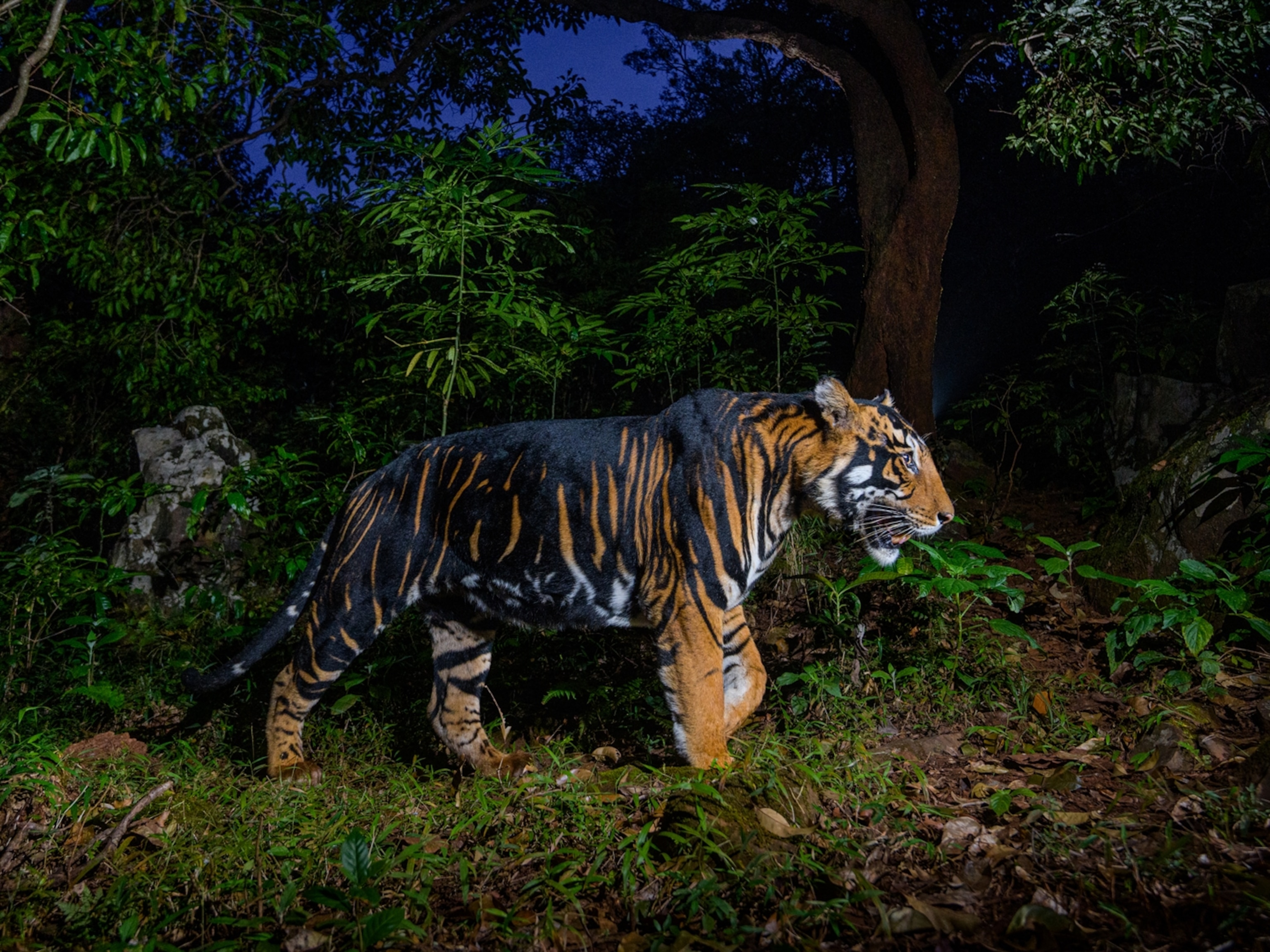From forest to table: Inside the world’s bushmeat problem
Growing demand for wild meat for subsistence as a luxury food is emptying forests and risking spread of deadly diseases.

Beneath a rainbow of colorful shade umbrellas, Poto Poto Market clamors with merchants selling goods: smoked fish, papayas, eggplants, dresses, children’s school supplies, flip-flops. It’s a Saturday morning in Brazzaville, the pulsing capital of the Republic of the Congo, and Honor Toudissa, strolling the aisles, pauses to examine two large catfish thrashing in a shallow bin of water. He offers a woman wearing a pink T-shirt and yellow headscarf seven dollars for the pair. Pleased, she places the fish on her wooden butcher block and chops their heads off with her machete: Whack!
Toudissa, who has appeared on Congolese television and in international cooking competitions, is buying fresh catfish to make a traditional dish called liboké. He’ll marinate them by hand in garlic, pepper, oil, and basil, wrap the mixed ingredients in arrowroot leaves cinched with string, and grill the bundles over a charcoal fire. From other merchants he buys beef raised by local pastoral cattle herders rather than on industrial farms in Brazil, Germany, and other faraway countries. He also buys ginger, green onions, and live crickets and grubs—insects considered a delicacy here. Toudissa likes to use them in a green mango salad and chocolaty desserts.
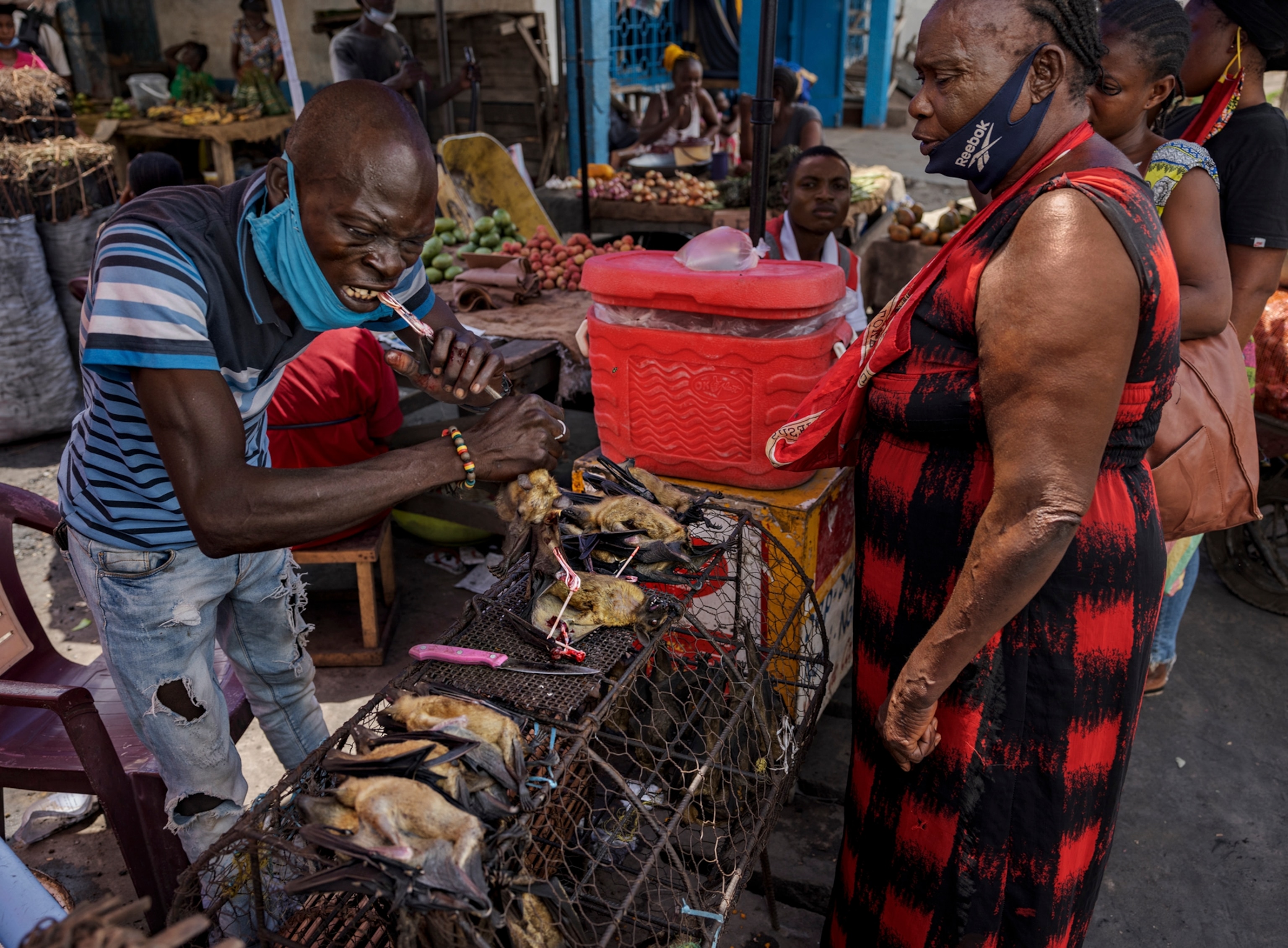
Eleven years ago, Toudissa’s popular Brazzaville restaurant, Espace Liboké, was destroyed when a military arms depot exploded, killing 246 people. His latest culinary venture is part of a mission to demonstrate that it’s possible to cook Congolese-style food without using wild game—bushmeat as it’s commonly called. Eating wild meat—everything from antelope, monkeys, and porcupines to endangered gorillas, elephants, and pangolins—has always been part of his country’s culture. But Toudissa is bucking the status quo. “If we kill all the animals, people will not have a chance to see them,” he said as we walked the crowded market aisles. “My food is natural. It comes from the water, farms, and forests—and it doesn’t include bushmeat.”

Toudissa is part of a novel campaign led by local Congolese staff with the Wildlife Conservation Society (WCS), a nonprofit headquartered in New York City that works to protect wildlife from poaching and other environmental threats. Focused on positive messaging rather than telling people what not to eat, the program celebrates the region’s gastronomy. Billboards, TV advertisements, YouTube cooking demonstrations, and a catchy jingle promote wild-meat-free Congolese recipes as yoka pimbo!—delicious!
The commercial wild meat trade is emptying forests in Africa and around the globe. Studies show that bushmeat consumption threatens more than 300 species of terrestrial mammals with extinction. Hunters target 200 species in the Amazon Basin, amounting to more than a million tons of meat annually. In Asia, rising demand in cities has created a booming market. In Vietnam, affluent men want wild meat as a way of signaling prestige and gaining social status, according to studies published during the past decade. In Madagascar, lemurs, which draw tourists from around the world, also appear on dinner tables in rural households. A shift to luxury consumption in cities, where bushmeat sells for twice the price, could threaten the survival of certain lemur species.

Wild meat can be found even in major European and U.S. cities. In 2019 the U.K.’s Border Force, the agency that secures the country’s ports, seized more than 2,200 pounds of wild meat, including chimpanzee and giraffe, from travelers entering the country. During the Christmas season in 2021, U.S. Customs and Border Protection agents at Minneapolis-St. Paul International Airport confiscated more than a hundred pounds of wild meat in one week.
For many rural communities in Central Africa, bushmeat has long been a staple food. But now what worries conservation groups most is the toll of overhunting on fragile forest ecosystems, driven by soaring demand for wild meat in big cities, particularly in Brazzaville and neighboring Kinshasa, the capital of the Democratic Republic of the Congo, which have a combined population of 16 million.
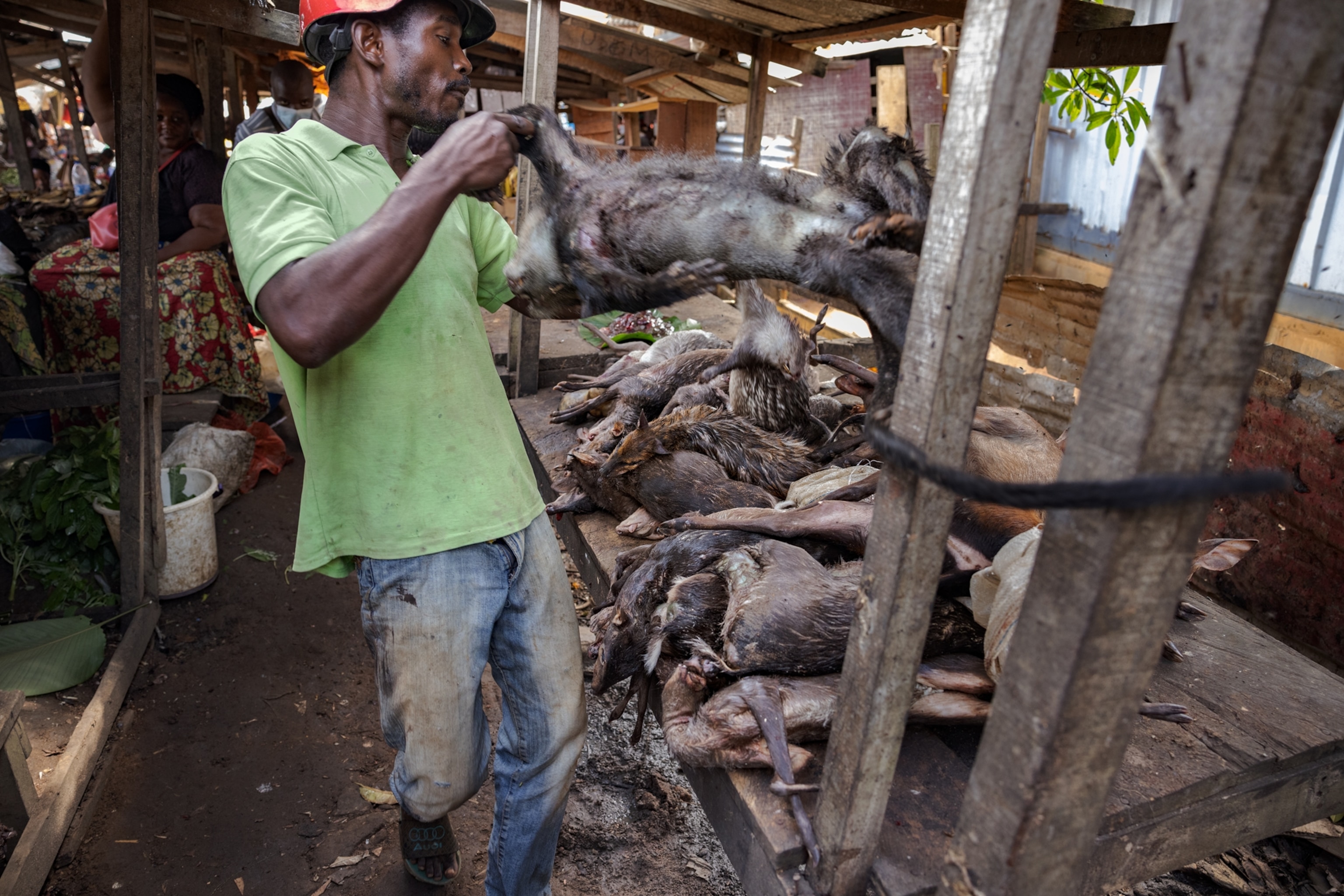

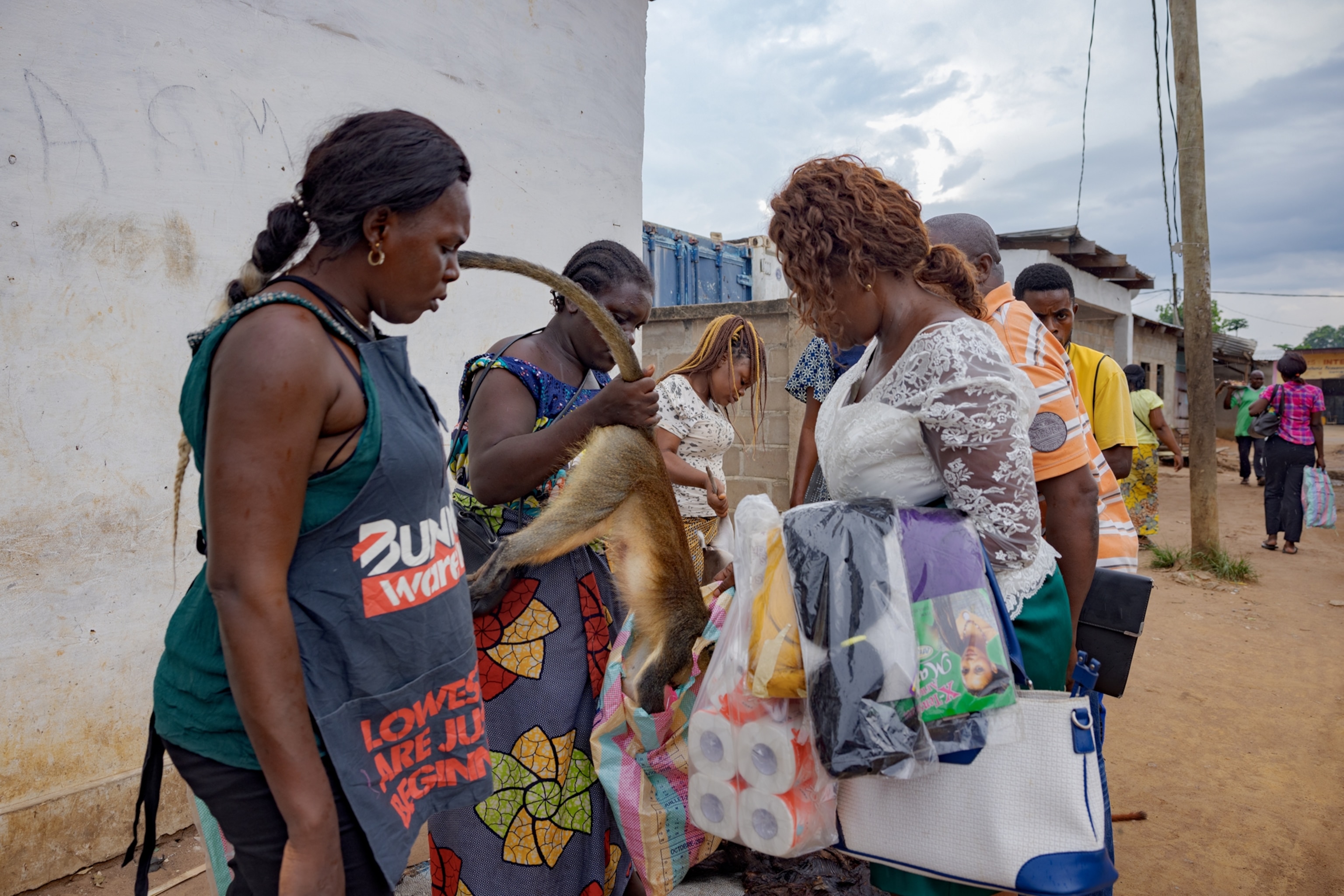
“Every year, more than five million tons of bushmeat are extracted from forests in the Congo Basin, and most of that is going to urban centers—not for subsistence but as a luxury product,” said Lude Kinzonzi. A campaign assistant with the WCS’s Bushmeat Project, which is attempting to protect wildlife by reducing urban demand for meat from the wild, Kinzonzi accompanied me on a three-week tour of the Republic of the Congo for a close look at the wild meat trade. If “extraction continues at this level, some wildlife will become extinct,” he said. “We’re hoping that the campaign can convince people in cities to choose locally raised alternatives to bushmeat.”
Lately, during what may be the worst pandemic since the Black Death of the mid-1300s, debates about how to thwart infectious diseases transmitted from wildlife to people have overtaken concerns about declining biodiversity resulting from the wild meat trade. More than 70 percent of diseases that have emerged in humans since the 1940s—including Ebola, HIV, monkeypox, and coronaviruses—came from wildlife. Human activity is the main cause of outbreaks, particularly our intrusion into wilderness areas for logging and farming, and the trading and eating of wild animals. A recent study of 16 commonly eaten species at wildlife markets in China found 71 mammalian viruses in the meat, including 18 of “potentially high risk” to people and domestic animals.
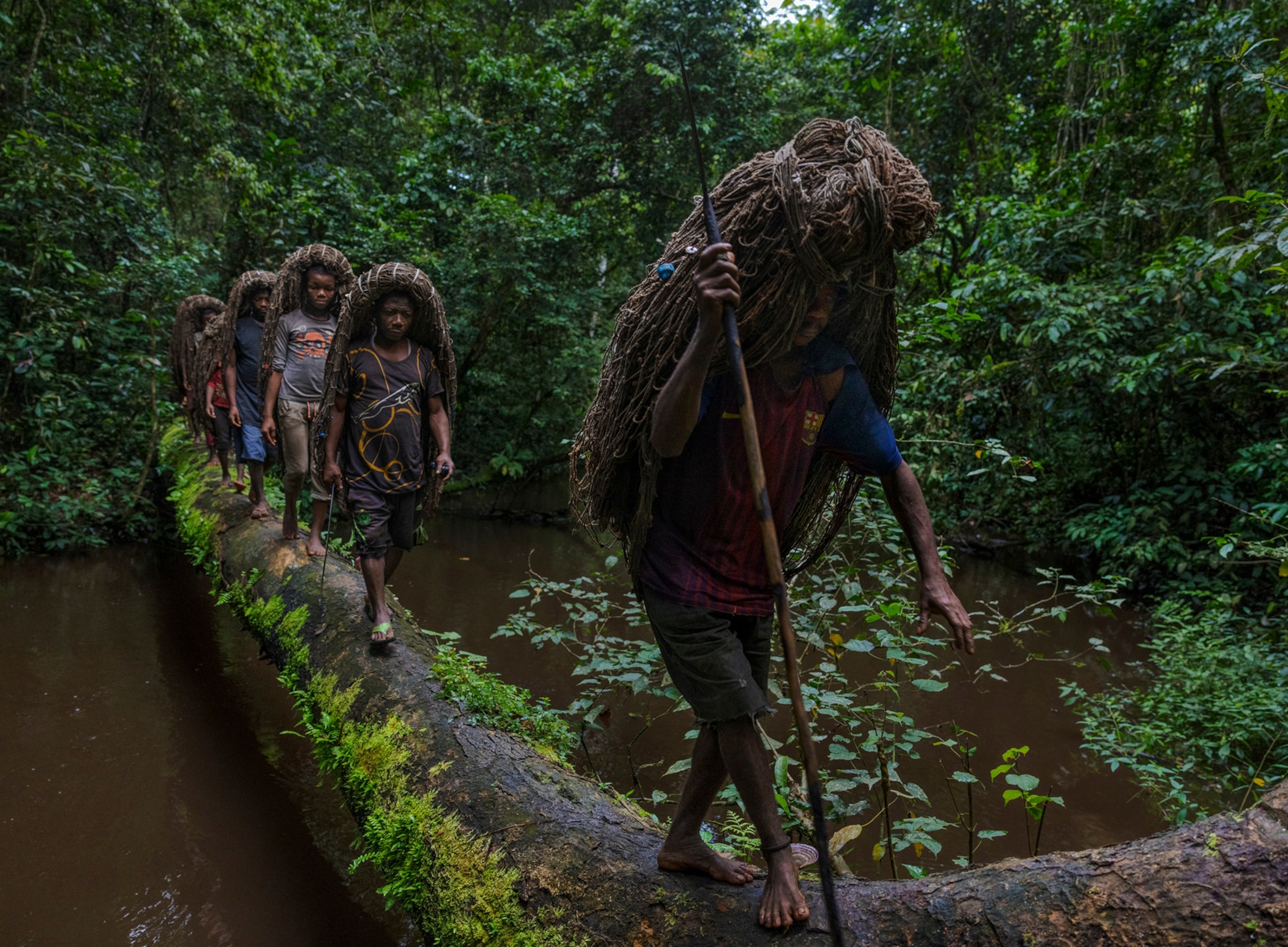
Amid ongoing discussions over the origins of COVID-19—which has killed nearly seven million people since it emerged in December 2019—some global health experts and animal activist groups have called for permanent bans on wild meat markets. Opponents argue that market closures could lead to food shortages and economic instability in impoverished regions. Others say that biodiversity and human health protections require instead a combination of more regulatory oversight of markets, limited wildlife sales, and a gradual cultural shift away from eating wild meat.
Since 2018, a consortium including WCS and the UN Food and Agriculture Organization has implemented the Sustainable Wildlife Management Programme in Central Africa, a hot spot for emerging animal-borne diseases. The program aims to fight the problem on several fronts: reducing luxury consumption of wild meat in towns and cities, supporting sustainable hunting initiatives, developing local farming ventures that can provide alternatives to wild meat, and undertaking wildlife disease research that can help inform public health decisions.
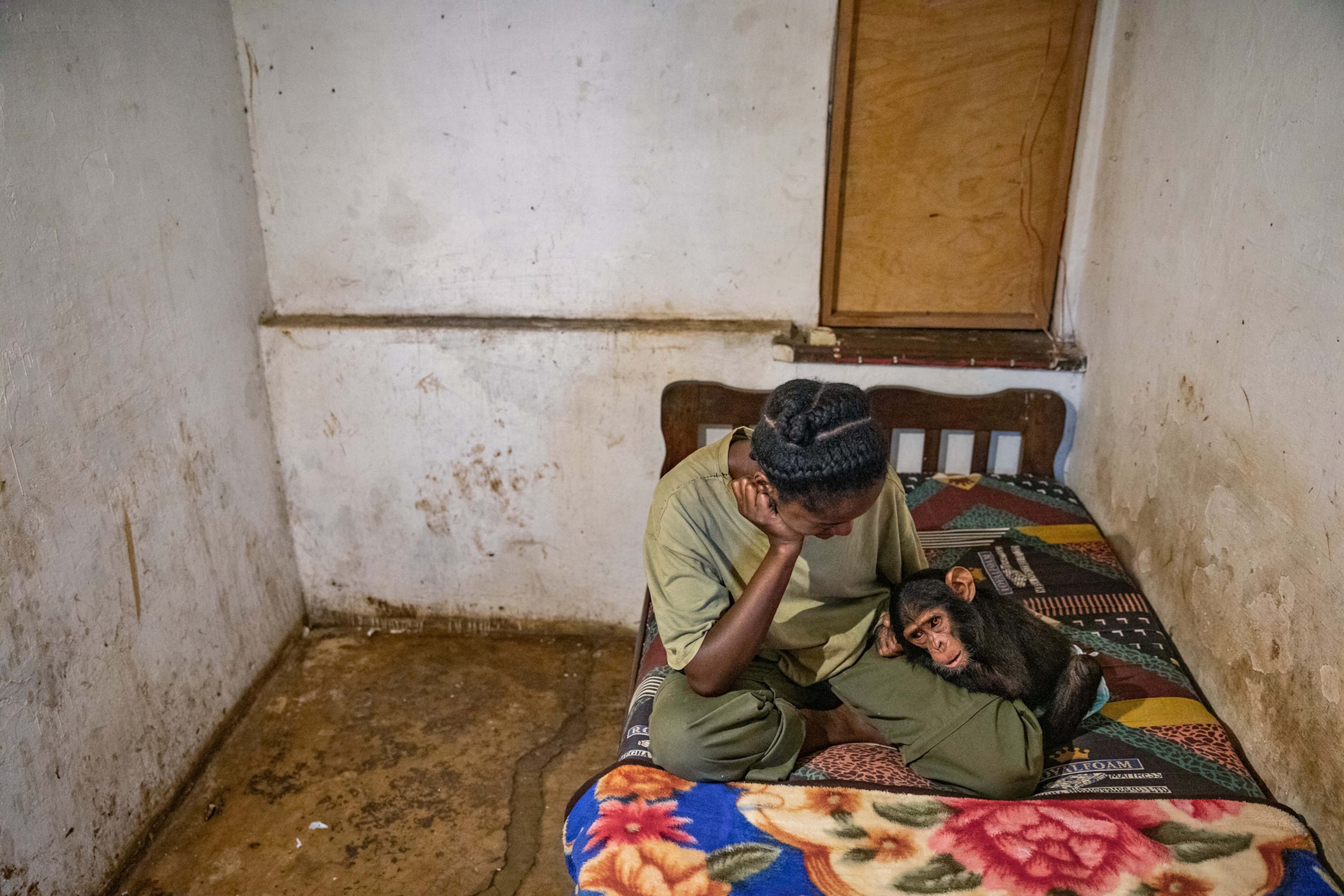
One obstacle to changing consumer behavior is a prejudice against frozen meats, including imported chicken, beef, and pork, which aren’t seen as “natural.” Research by WCS in three Central African cities (Pointe-Noire, Brazzaville, and Kinshasa) shows that 85 percent of people eat wild meat when they have the opportunity to do so and 24 percent of restaurants, which are sometimes based in private homes, sell wild meat.
Savoir Manger (French for “know how to eat”) in downtown Brazzaville sells only wild meat. Owner Stany Morobo welcomed Kinzonzi and me through a narrow cast-iron gate into a concrete courtyard situated between his house and a shaded dining area built from wood planks painted blue. T-shirts and towels hung on a washing line, and a pot of water was boiling on an open fire. The menu, written in white paint on the back of the entryway gate, offered fresh antelope, porcupine, pangolin, monkey, civet, python, and cane rat. “Pay before you eat: $1500 xaf [about U.S. $2.50], Bon Appetit.”

Morobo said his refrigerator was broken, so he had no food to offer, but smiling, he talked proudly about his cuisine. “It’s fresh meat, prepared naturally without a lot of seasoning so the taste really comes out,” he said. His most popular dishes are porcupine, monkey, pangolin, and red river hog. In some recipes, the meat’s juices meld in a broth of tomatoes, onions, and garlic. Every meal is spiced to taste with red chili pepper and sopped up with traditional doughy bread made from cassava flour.
Morobo said he buys his meat directly from hunters in villages close to forests. He knows that some threatened species are prohibited. “Normally, python and pangolin are not authorized, and some monkeys are illegal to sell,” he said. “It can be difficult to get them. You just have to be really careful. If the ecoguards catch you, you’ll get five years in prison.” He evades them by hiding the meat in his car, he explained. Morobo often supplies wild meat to other restaurants, private homes, and even travelers from France and other far-off places who sneak meat home in their suitcases. “People are lovers of this meat,” he said. “They like it so much. They have to have it.”
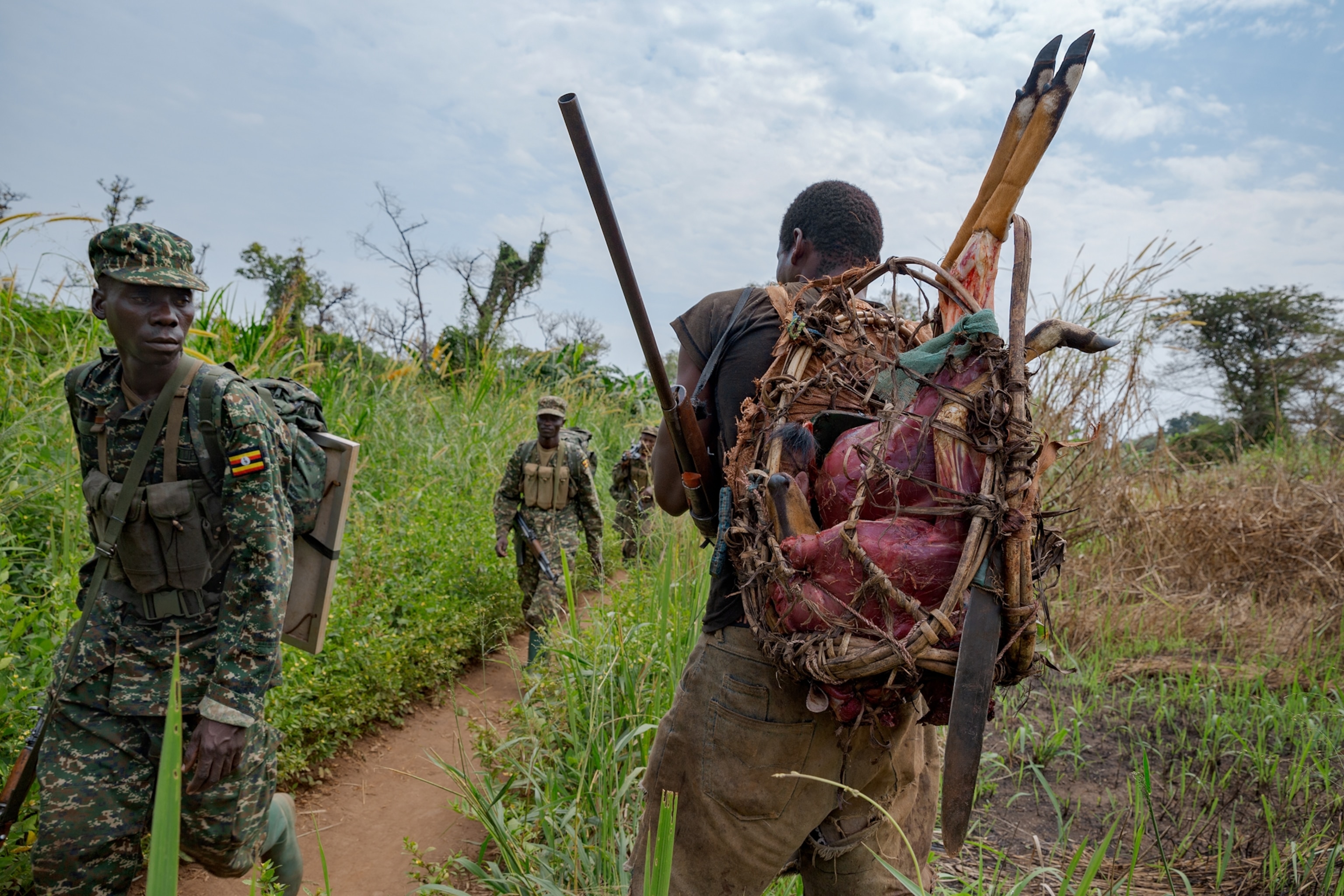
Even though Kinzonzi seeks to reduce the consumption of wild meat, he understands the craving for it. When Kinzonzi was a boy, his father would often cook meat from the forest for his family. Grilled civet, a catlike mammal with a long body, thick furry tail, and short legs, was his favorite. “Eating bushmeat is part of my culture,” he said. “But if we want people to change their behavior, I needed to be the first person to move in that direction.” Kinzonzi added that he took his last bite from the wild four years ago.
Recently he and his colleagues have seen a worrying trend in some markets. Every day from late September through early December in Total Market in downtown Brazzaville, men prepare live straw-colored fruit bats for customers’ cook pots. First, they kill the bats with a smack on the concrete. Then they debone the wings with their teeth. Worldwide, fruit bats are commonly eaten by people living close to forests, but some wildlife and public health experts are concerned about this commercial-scale trade, particularly when preparation exposes people to bats’ bodily fluids.


Early one morning, Kinzonzi and I left Brazzaville and joined David Lakoutelamio and three fellow bat collectors along the banks of the Congo River. The men loaded oblong wooden cages into a dugout canoe. Paddling hard across the river’s strong current, they charted a course for the tiny island of Île de Chie in the middle of the river. Lakoutelamio traipsed into the forest to check his 14 mesh mist nets, each spanning more than two school buses in length and at least two stories in height. As he lowered a net with a rope and worked on removing a bat, I asked if he worries about being exposed to a disease through his close interaction with the animals. He replied that it’s not possible to get diseases from these bats because they eat healthy diets of mainly fruits. “If a bat bites you, it will hurt a lot,” he said, “but it won’t make you sick.”
With ironclad immune systems, bats can be infected with viruses and not fall sick. This makes them ideally suited for spreading disease to humans in close contact with them. If a person happens to encounter a bat’s blood or body fluids when it’s shedding a virus, there’s an opportunity for a disease to spill over.
Bats have long been suspected as the likely vector for Ebola and other disease outbreaks, and they remain a target for researchers studying animals capable of harboring a wide array of diseases. In a study published in 2021, a consortium of researchers with funding from USAID tested more than 3,500 bats, rodents, and primates in the Congo Basin for any sign of coronavirus. They found the marker sequences in 121 animals, of which all but two were bats.
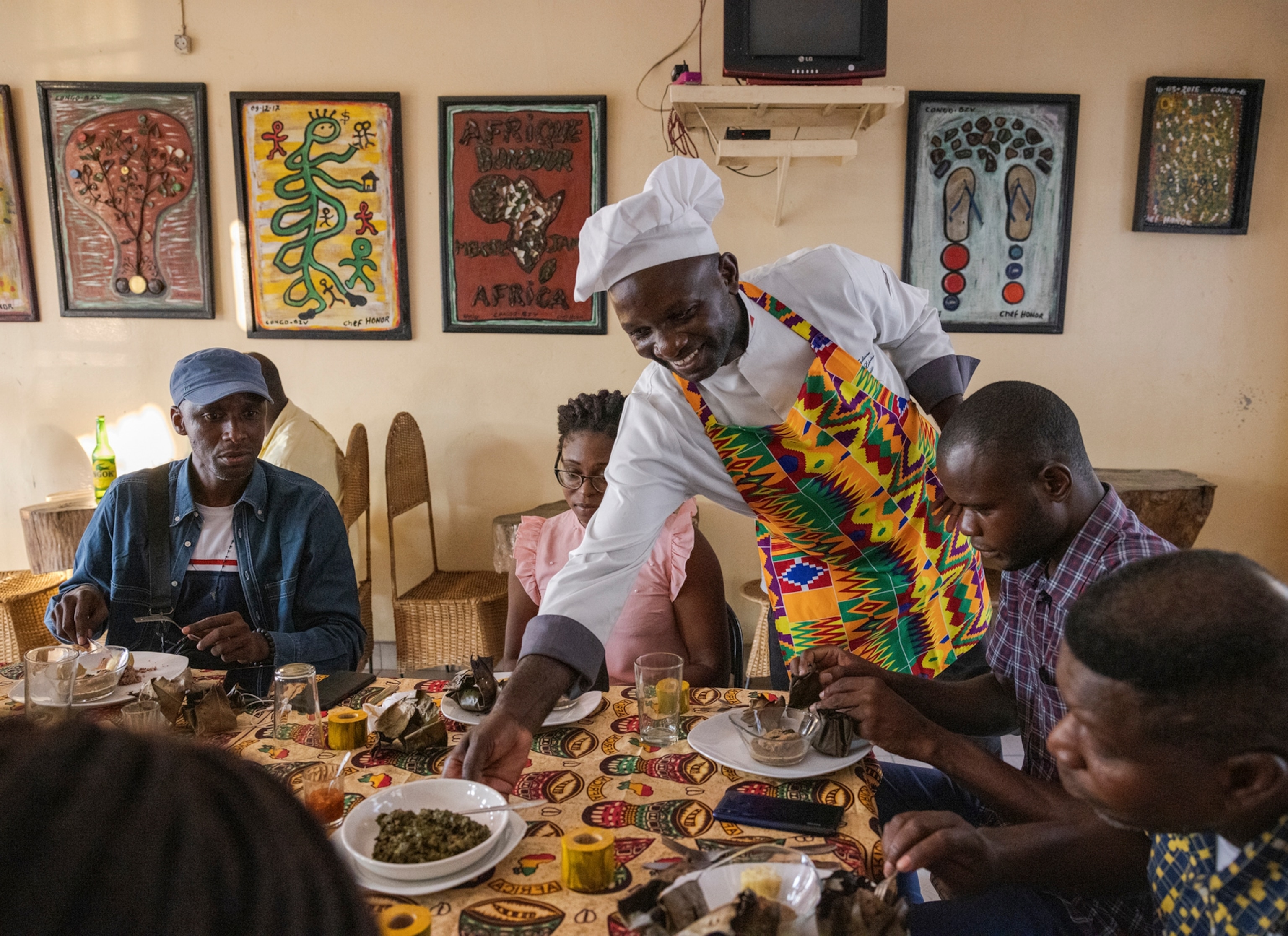
WCS has launched a new study to learn more about bat hunting on Île de Chie and at other sites, including blood testing to ascertain whether the animals are carrying antibodies for Ebola and other diseases. “This bat trade seems risky from a health perspective,” Michelle Wieland, WCS’s Africa director for rights and communities, says. “It could be ground zero for another outbreak.”
Much of the wild meat in Brazzaville funnels through the city of Ouésso, on the west bank of the Sangha River, more than 500 miles to the north. With about 30,000 people, Ouésso is what’s considered protein poor, and eating food from the forest is not a luxury but a necessity. Diets here include fish, wild meats, vegetables, cassava bread, and domestic and imported meats.
Ouésso is both a port and a gateway to northern logging concessions ringing one of the most remote rainforests on the planet, the more than 1,500-square-mile Nouabalé-Ndoki National Park, on the border of the Central African Republic. Each day at sunrise, dugouts leave Ouésso to collect wild meat from dozens of tiny villages along the riverbanks. When the boats return, young men cart the goods to the town markets, where some meat is smoked on the spot and women with babies swaddled on their backs barter with vendors for the best prices.

More than 80 ecoguards, employed by the government, operate mobile patrols to prevent hunters and ivory poachers from penetrating Nouabalé-Ndoki, which Time magazine once called the Last Eden for its pristine forests, western lowland gorillas, chimpanzees, and forest elephants. Interactions between ecoguards and local communities have caused conflict, but the prevention of poaching has been effective. Guards caught an ivory poacher, Mobanza Mobembo Gerard, who with 25 accomplices killed an estimated 500 elephants between 2008 and 2020. His 30-year prison sentence for killing elephants and shooting at the guards was the most severe penalty ever given for a wildlife crime in the region.
Gorillas, elephants, and chimpanzees, all endangered, used to be common in Ouésso’s markets. Increased protections and the threat of a prison sentence for anyone caught killing or transporting those animals have made it rare now to find them for sale, though officials suspect they’re still sold secretly. At Ouésso’s main market, I saw antelope and monkey meat being smoked on charcoal pyres. Sellers butchered animals as they arrived. Humanlike hands and feet of putty-nosed monkeys, identifiable by the white patch on their noses, and De Brazza’s monkeys, named for the Italian explorer who founded Brazzaville, lay discarded at the edge of chopping blocks.

Because it’s impossible to know where the animals were killed, there’s no way to determine if they were hunted legally. So police stick to enforcing laws related to protected species. One meat vendor told me she wished she could go back to selling gorilla, elephant, and bongo (a protected antelope); that would make her rich, she said. “People would celebrate.”
Most wild meat pouring into Ouésso—and beyond to Brazzaville and Kinshasa, where it’s sold for more than twice the price—is supplied by small hunting camps, rural forest villages, and logging concessions. These concessions are ubiquitous, Wieland says, and many timber companies don’t care if their truck drivers carry illegal bushmeat. But one company, Congolaise Industrielle des Bois, has been working with WCS and the government’s Ministry of Forest Economy for almost 24 years to provide a better example. Along with WCS, the company funds a program that pays for ecoguards to patrol timber concessions and transit routes for bushmeat traffickers and supports sustainable hunting for its workers, who in the past have hired Indigenous hunter-gatherers to kill animals. A Ba’Aka man, Richard Bokoba, told me the loggers either give him cash—a red duiker carcass gets about $25—or they let him keep the intestines to feed himself, his wife, and their five children. Because the family can live on plants, mushrooms, and small rodents, Bokoba said, he usually takes the money for cooking oil, medicine, sometimes clothing.
In addition to promoting sustainable hunting, the program supports small-scale livestock farming in places like Ouésso, where I met Pierrette Bouesso, who sells homemade yogurt, cakes, and Congolese dishes. She was preparing to receive 200 chickens from the program’s husbandry initiative, which had also provided some small business training. Her chicken will be costlier than supermarket poultry but more ecologically sustainable than bushmeat, and she’s confident she’ll have buyers. A divorced woman supporting children and grandchildren, she said the additional income will be very helpful in providing for her family’s needs.

In Brazzaville and other major cities, eating bushmeat is like dining on lobster in the United States—a luxury. As we sat for a meal at Chef Toudissa’s table, Kinzonzi told me people sometimes ask him, If I don’t buy bushmeat, what will I buy? Imported meat that can make me sick? This, he said, is how he replies: “No, if you can afford bushmeat, you can afford goat, or beef, or local chicken.”
Toudissa is showing people how to savor the flavors of their heritage without wiping out wildlife. As the sun set, he presented an appetizer of crickets and grubs sautéed with fresh mangoes gathered from the trees in his yard. The grubs were shrimplike in texture. Two types of liboké, catfish and beef, were stewed in herbs, tomatoes, cucumbers, and garlic. The beef was tender and the fish savory in its pepper and onion broth. A cassava pudding was topped with sweet jams made from mangoes and a rainforest fruit called mbila ya esobe.
The meal was among the first of many that Toudissa planned to host in his courtyard, where he’s building a culinary school, Village Liboké, to teach others, from small children to professional chefs, to cook bushmeat-free Congolese cuisine, preserving the forests and the animals living in them.
Brent Stirton’s images were recognized by the Wildlife Photographer of the Year contest and Visa Pour l’Image. The Sustainable Wildlife Management Programme supported Stirton’s work on this project.
This story appears in the June 2023 issue of National Geographic magazine.




